WORLD CLASS COACHING
Club Curriculum Fun Training Games
By Tony Englund
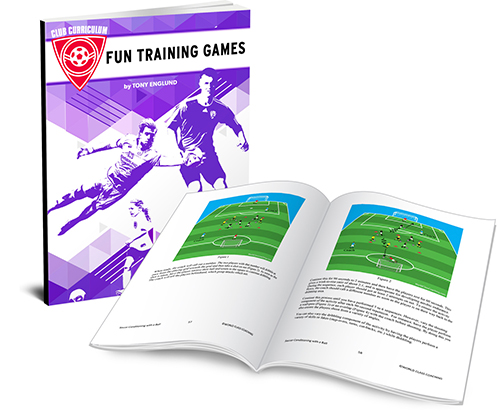
TABLE OF CONTENTS
Part Three
PASSING & BALL STRIKING GAMES
Part II: Games teaching passing and striking the ball
Coaching Points
Passing
• Plant the non-striking foot so that the toes point in the direction of the pass.
• Lock the ankle and all points below the hip on the striking foot.
• Use the long inside surface to strike the ball.
• Strike the back of the ball.
• Follow through holding the foot showing the inside of the foot to the target.
Receiving
• Be sure to be in a balanced body position to receive.
• Extend the receiving foot, opening up the long inside surface to receive.
• Cushion the ball by pulling the foot back toward the body at the moment of contact.
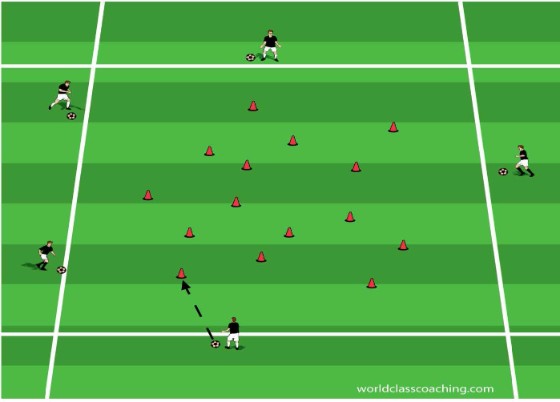
The great cone shoot-out - 15x15 yard grid
Each player needs a ball. Spread a large number of tall cones around the interior of the grid. The players spread out around the perimeter of the grid. At a signal from the coach, the players strike their ball in an effort to knock down a cone. Then they chase their ball, being careful to avoid other players’ balls and the cones. They also pick up any cone they knocked over with their strike and carry the cone(s) with them. Once they have recovered their ball and any cones, they go to the perimeter of the grid and strike the ball again. This is a fun game that lets the players experiment with their striking technique. When all cones are down, see who has knocked down the largest number and reset the game.
Variation
• Use the off foot to strike the ball.
• Make the grid smaller or larger to challenge or build confidence in players.
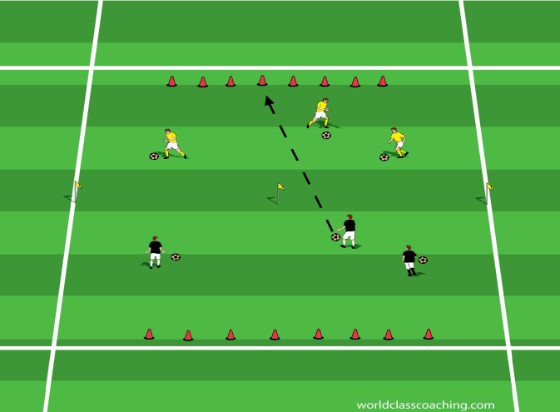
Fire away - Two side-by-side 10x15 yard grids
Divide the group into two teams. Each team occupies one of the grids. Explain that no player can enter the other team’s grid during the game, and players can only leave their own grid to retrieve a ball. Stand 8 tall cones at the back of each team’s grid. The goal of the game is to strike the ball in an attempt to knock down the other team’s cones. The first team to knock down all of the cones in the other team’s zone wins. In the first round of the game, do not allow players to block shots by the other team, as it is important that immediate success is achieved.
Variations
• Before commencing the second round of the game, instruct players that they may block a shot by the other team, but that they may not use their hands and they must be careful not to step in the way of a strike that might hurt at this age. It is also useful to explain that shots may only be “saved” near the cones, so that players do not stand near the center line and block shots.
• A third variation is to create a neutral, central zone, where players can shoot and can also challenge to win the ball. Players can thus get closer to their targets before shooting, and the shooting is now contested, making the exercise more game-like.
Cops and Robbers - 20x20yard grid with a circle (3 yards in diameter, outlined in cones) in the center
Two ‘police officers’ without soccer balls and wearing distinctive vests, patrol the area outside the circle (they cannot enter the circle). The ‘robbers’ are players outside the grid area, each with a ball. The robbers try to dribble into the circle area and grab ‘loot’ (vests, cones, etc.) and carry it back out beyond the perimeter of the grid to their ‘hideaway.’ If the police officers can kick away the robber’s ball, she must return the loot and then get her ball again and try to ‘break in’ once more. Play until all of the loot is removed or for three minutes and then change police officers.
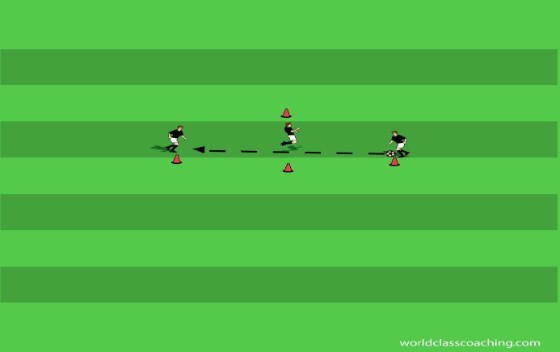
Dodgeball - 10x15 yard areas
Players work in 3’s with one ball. One player is located on each end of the area and one of the end players has a ball. The third player is the target and she must remain on the line between the center cones. The endline players try to strike the ball on the ground so that it makes contact with the center player. Emphasize safety and playing on the ground! If the center player dodges five consecutive passes, she wins and a new player moves to the middle. If she is hit by the ball (on the ground), the passer moves to the middle and play continues.
Coaching Point
• Encourage players to think about both accuracy and the pace of the strike necessary to be successful.
Variation
• Adjust distances to increase or decrease the difficulty for the shooters.
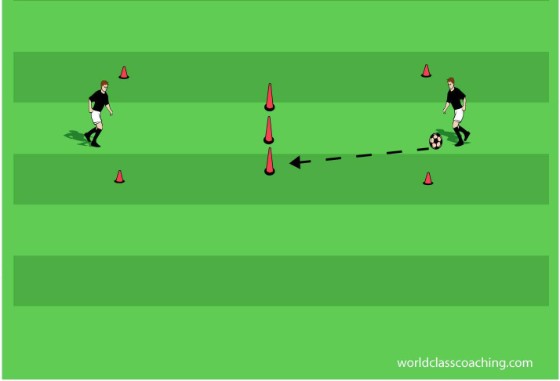
Bowling! - 4x12 yard lanes
Players work in pairs with one ball. Put one player at each end of the lane and give one player the ball to start. Place three tall cones in the middle of the lane. Players take turns passing the ball in an attempt to knock over the cones. When one player has knocked down two cones, she wins that “frame” and the cones are reset to play again. The key points of emphasis are the use of the inside surface (accuracy), locking the ankle of the passing foot, and pointing the toes of the standing foot toward the target cone.
Variations
• The coach should adjust the length of the lane so that players are challenged but also enjoy some success.
• Play for five minutes and then change partners and play again.
• It is also useful to require players to play a frame or more with their “off” foot.
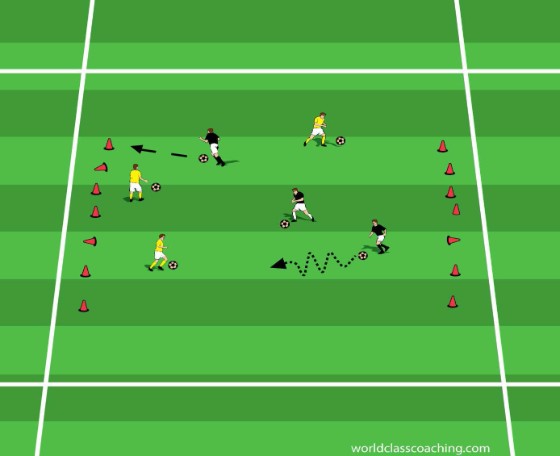
Cone Crashers - 20x25 yard grid
Divide the group into two teams and give each team ½ as many balls as the number of players on the team. Each team defends one end of the grid and the tall cones standing on that end. Players with a ball dribble to the other end of the grid and try to strike the ball to knock over a cone on that end. Emphasize that roles change in this game. If one is defending and wins the ball, one should go over to the attack. The team must cooperate to both defend and attack throughout the game. The defenders can stand in front of a cone and block attempts to knock over the cone. The first team to knock over all of their opponents’ cones wins. This is a fun, wide open game that presents lots of 1v1 duels and opportunities to strike and block the ball.
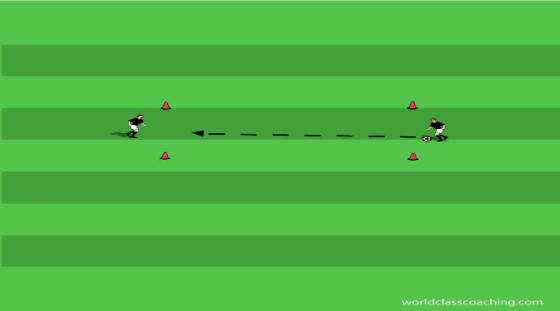
Table-top - 5x10 yard grids
Players work in pairs with a soccer ball in each grid. Players stand beyond the end of their grid. The goal of the game is to pass the ball to the other end of the grid so that it will stop on the cone line. Any ball that rolls to a stop there earns a point. Here, the emphasis is less on the angle of the strike and more on the pace of the strike necessary to put the ball in a particular spot. The coach should emphasize weight of the push on the passing foot being critical to success in putting the ball at the edge of the “table-top.”
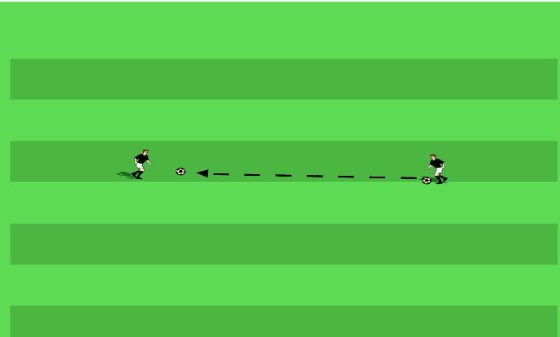
Marbles-½ field
Players work in pairs with two soccer balls. Demonstrate with one group. The players stand ten yards apart. One player passes her ball in an attempt to hit her partner’s ball. If she misses, then the partner waits for the first ball to roll to a stop before she takes her turn. When one player is successful, then the players move to a ten-yard distance again and then her partner re-starts play. Give one point for each strike that is successful. Play for two minutes and then check points before changing partners.
Variations:
• Adjust the starting distance between players.
• All shots must be taken with the ‘off’ foot.
Human croquet - 3x8 yard areas
In groups of three with one soccer ball, players line up with two players on the ends and one person in the middle. The middle player stands with her legs apart and the end line players take turns trying to pass the ball between the legs of the standing player. Play for one minute and then change the middle player. Keep track of points and see which team can score the most goals.
Variations:
• Require passes be made with the ‘off’ foot.
• Vary the distance to the player in the middle.
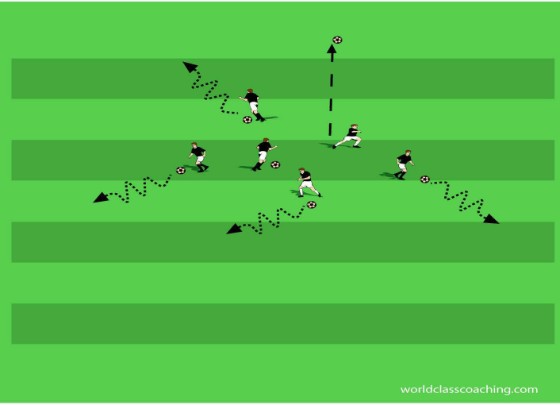
Fountain spray - 20x20 yard area
One player holds a ball while the others stand 2-3 yards away in a circle around the ball holder. The player with the ball throws it up in the air and then calls out the name of one of the other players. That player tries to catch the ball before it hits the ground while the rest of the players run away. If the ball is caught, the sequence is repeated. If the ball hits the ground, the player whose name was called settles the ball and hollers ‘freeze!’ The other players must stop in place. The player with the ball tries to pass the ball to hit the feet of any of the other players. The target player retrieves the ball and becomes the next server. This game combines a chance to work on some passing accuracy with introducing players to judging and controlling a ball in the air.
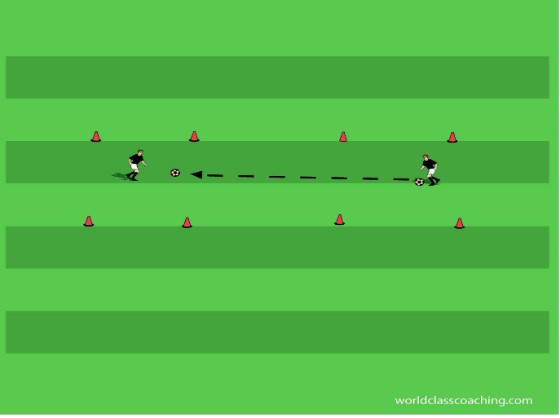
Grid Wars - 2 10x10 yard grids ten yards apart
Place one player in each grid. Use one ball per pair. Players alternate striking the ball with the goal of trying to get the ball to roll to a stop inside their partner’s grid. Each successful strike earns a point. This is a useful exercise in that it compels the players to think about both placement and pace in their shots. Require players to shoot with their laces surface throughout. Play for three minutes and check scores.
Variations
• Play with the off foot only.
• Create a smaller, target box inside each grid and give extra points for the added accuracy.
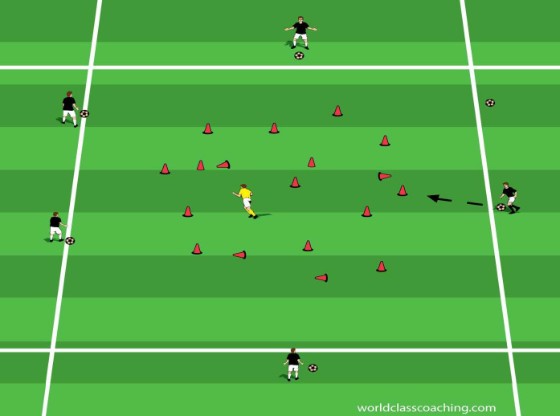
Cone Medic - 20x20 yard grid
The cone medic starts inside the grid. All other players are on the outside of the grid. At a signal from the coach, all players enter the grid and try to knock over the cones using their balls. The cone medic works to stand up cones as fast as possible. Play until all of the cones are down or for one minute and then change medics.
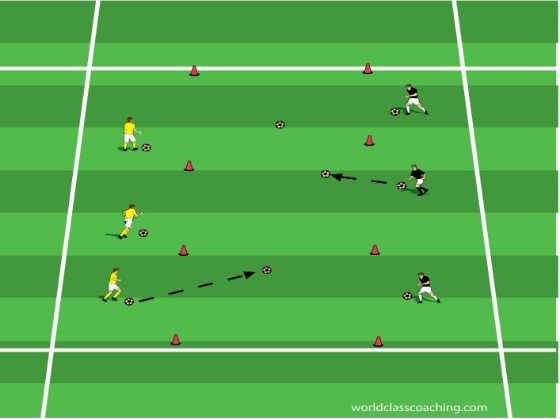
Cue ball - 25x12 yard area
Put a ball (or two) of a distinctive color in the middle of the grid. Put a ball supply in each end zone and put half of the players in each of the end zones. Explain that the goal of the game is to pass a ball from the end zone to strike the ball in the center. The target ball must be knocked into the opposing end zone to earn a point. Players may only enter the center area to retrieve a ball. If the target ball is knocked into a team’s end zone, they pick it up and run it back to the center and play continues. Teams may kick a cue ball at a target ball rolling toward their end zone in an effort to keep it from crossing the line. Play for five minutes and then check scores.
Variations
• Adjust the size of the center area to increase the challenge or success rate.
• All shots must be taken with the ‘off’ foot.
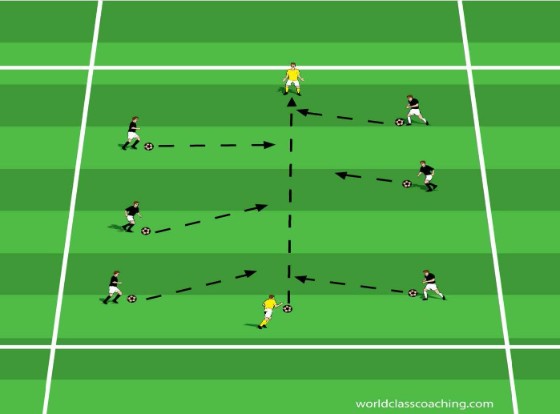
Duck Hunting - ¼ field
Select two players to pass a ball to each other. They stand in the middle of the area, ten yards apart. The remaining players stand with a ball on the side of the area so that they can kick their ball to try to hit the target ball when it is passed. Play once, then the players retrieve their balls and try again from the other side. Play for two minutes and then change the passing pair.
Variations
• Adjust the size of the center area to increase the challenge or success rate.
• All shots must be taken with the ‘off’ foot.


